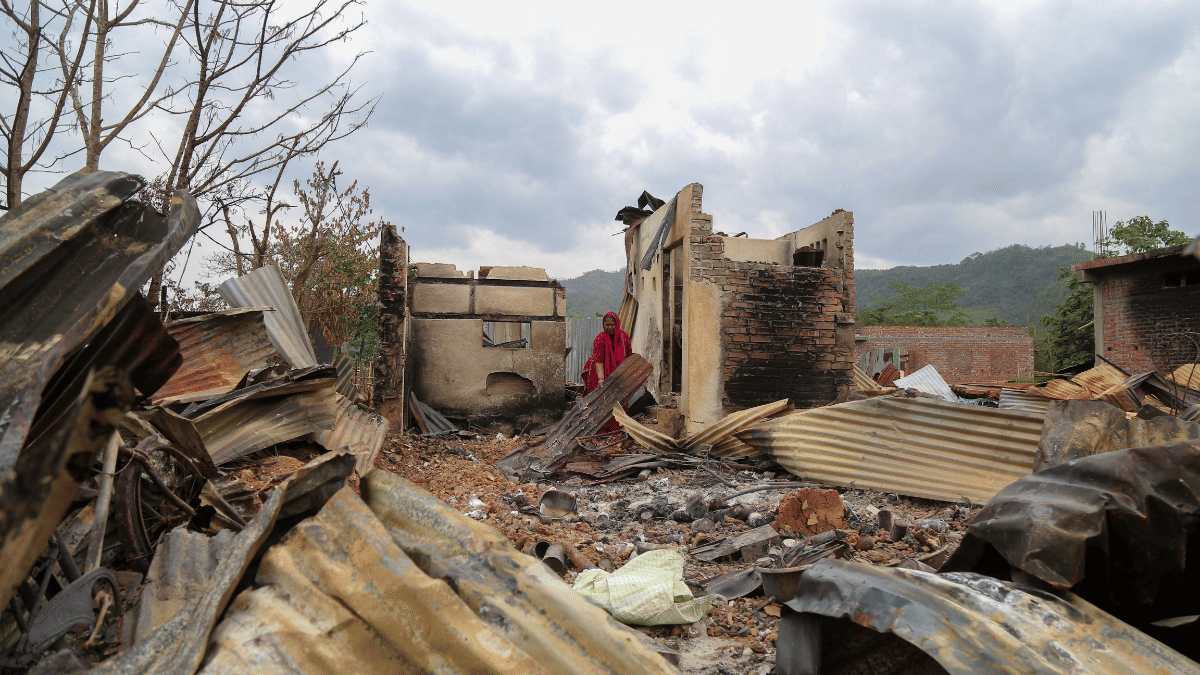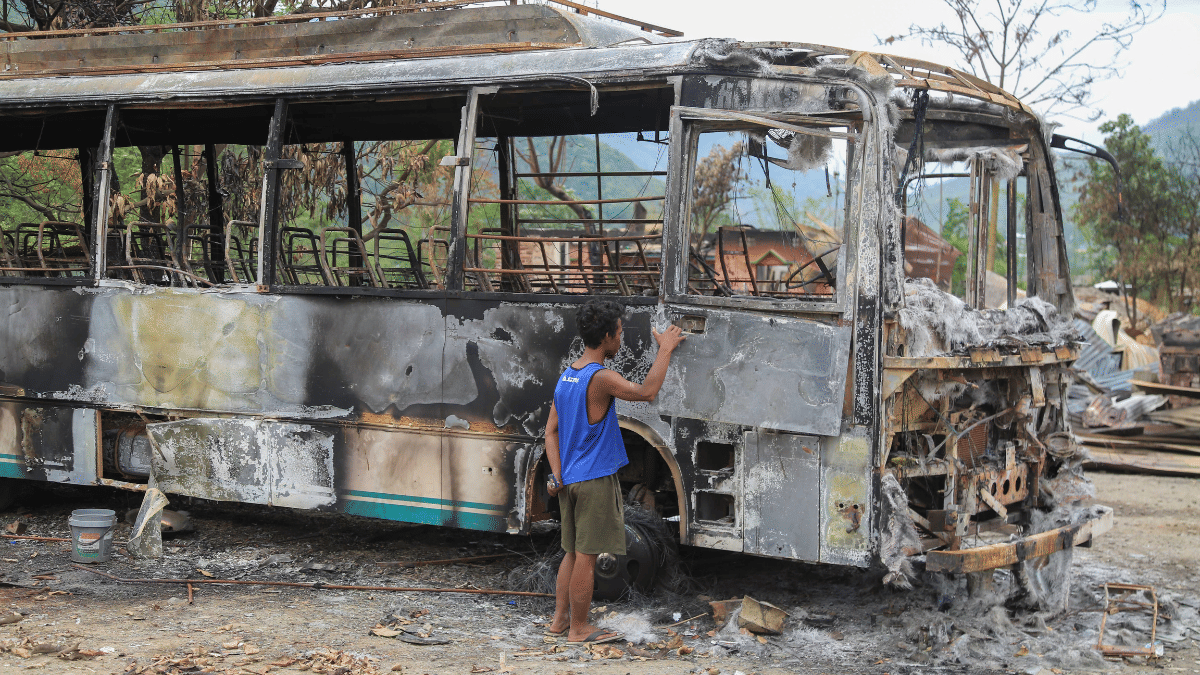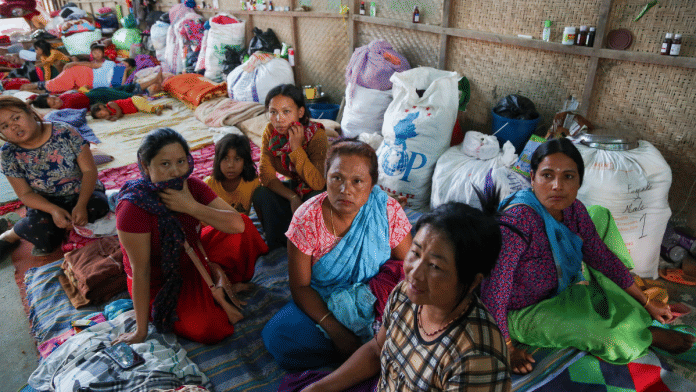Dolaithabi, Manipur: A strong burning smell engulfs the air as one enters the bazaar at Ekou, a small Meitei hamlet inside the Kuki-dominated Dolaithabi village in Manipur’s Kangpokpi district, some 35 km away from the capital Imphal.
A handful of distraught villagers is rummaging through remnants of their burnt houses and shops to see if they can recover anything.
On the evening of 3 May, the bazaar and adjoining areas of Ekou, which had 140 houses inhabited mostly by Meiteis, bore the brunt of the violence that broke out following the ‘Tribal Solidarity March’ held to protest plans to give Scheduled Tribe status to non-tribal Meiteis.
The clashes, which took place primarily between the Meiteis and the Kukis, have claimed close to 60 lives. Curfew has been imposed and the internet suspended in the violence-hit districts, including Imphal, since the clashes broke out.
Villagers at Ekou, with a total population of around 700 people, told ThePrint that a mob entered the village around 5.30-6 pm, and started vandalising homes before setting them on fire. Over 100 houses and shops, besides a school, and a public transport bus were set ablaze.
While most of the Meitei villagers fled and took shelter in Pukhao Terapur, a Meitei-dominated village just a few km away, some went to the Assam Rifles camp in the adjoining Saikul village near Dolaithabi. The Assam Rifles erected a relief camp for the rescued villagers the next day.
On Saturday morning, when ThePrint reached Ekou, Ram Ashish and his wife Urmila, who ran a grocery shop in the bazaar area for close to 15 years, had come from the Saikul relief camp to see what was left of their house and shop.

A native of Gorakhpur, Uttar Pradesh, Ram Ashish’s father had come to Manipur about 30 years ago and eventually settled in Ekou. Ashish grew up in this Meitei hamlet, and his son, who studies at a college in Imphal, was born here.
“I am not a Meitei or a Kuki but have become a victim of their conflict. Here, I have lived adjacent to Meiteis and Kukis all my life,” he told ThePrint. “Never did I imagine that I will have to see a day like this where we will have to rummage through the remains of our burnt house.”
The only inhabitants that one can see now in Ekou and the surrounding villages are personnel of Assam Rifles, Border Security Force, India Reserve Battalion, the CRPF, and the Army’s Gorkha regiment.
Meanwhile, at a press conference Monday, Chief Minister N. Biren Singh said that the government is doing all it can to provide relief to the rescued victims and also working along with the district administration to rehabilitate the displaced people.
Also Read: Tripartite ceasefire pact to settle Kuki issues operational, says security adviser to Manipur CM
‘Left our home in panic’
If the Meitei pockets in Kuki-dominated villages wear a deserted look, things are no different in nearby Kuki pockets adjoining Meitei-dominated villages.
Here, villages say they fled their homes on 3 May, “fearing retaliation from the Meiteis”, and are taking shelter in relief camps.

Pao Khup, 70, lives in Songphel, a small Kuki hamlet with about 10-15 houses, located adjacent to a Meitei-dominated village. Khup along with his family and other villagers left for a relief camp in Saikul on 4 May.
Khup said there was panic in their locality when they heard that a nearby Meitei hamlet was gutted by a mob. “Our hamlet just has 15-20 men and we were scared that, in case of a retaliatory attack, we would not be able to protect our families. So, the villagers decided to move to the nearest Assam Rifles camp.”
On Saturday morning, Khup was going to his village to collect some clothes for his family. “We left our home in a panic, without taking anything, not even a single piece of clothing,” Khup told ThePrint.
From Saikul, he and some other villagers walked all the way to Ekou, where they managed to get a lift in an Assam Rifles patrol truck.
Khup said that irrespective of who is involved in the violence, it is always poor people like him who suffer.
“Can you see the ridiculousness of all this? Villagers who have lived next to each other for ages are fleeing each other. The Kukis living near Meitei-dominated villages are running away fearing retaliation and vice versa,” he said.
With empty houses all around, many of the hamlets in the area resemble ghost villages. Even religious places like temples and churches have not been spared in the area.
Also Read: Manipur has a ‘hill of poppies’ problem. But CM’s war on drugs must tackle land issues first
Men from both communities stand guard
With fear and paranoia in the area, young men stand guard at the entry points of their respective villages.
Take the instance of Gangpijang, a small Kuki village in Kangpokpi district, just 2 km away from Pukhao Terapur, a Meitei-dominated village.
Young men stand guard outside the village, which has some 100 houses with a total population of 550. Mangcha Haokip, 48, a government school teacher, is one of the villagers standing guard.
Talking to ThePrint, Haokip said they had packed off the women, children and elderly to the Saikul relief camp. “The men have stayed back to safeguard the village,” he said.
Inside the village, he added, there is still tension. “We do not rely on the state forces. Because of the Assam Rifles and paramilitary forces, sent by the central government, we are a little relaxed. But still, there is no peace of mind,” he said.

According to him, the problem in Dolaithabi started because one of the nearby Kuki villages, Khonomphai, located in the middle of the Imphal-Saikhul road, was burnt down.
“Because of that, the nearby village occupied by the Meiteis was set ablaze by the angry mob. It was a reaction,” he said.
It is a similar situation on the other side too. About 600 m from where Dolaithabi ends is Pukhao Terapur.
There are about 150 households in this village, with an approximate population of 1,000. Most of the villagers are small farmers. A community hall in the village has been turned into a guard room, at the point where Pukhao Terapur ends.
Young men from the village stand vigil here in shifts, trying to safeguard their village from possible attacks by the Kukis.
Sanjoy Singh, 39, who runs a small grocery business in the village, is one of the guards. “There is no option. We must protect our village from the Kukis,” he said. “Ours is a double responsibility because we are also sheltering hundreds of people from our community, whose houses were burnt by the mob in Ekou and Sadu Yengkhuman.”
‘Where is the state govt?’
In Pukhao Terapur and adjoining areas, a few dozen relief camps — small and big — have been set up to provide shelter to hundreds of villagers rendered homeless.
Outside of Imphal, most of the relief camps are being run by either the security agencies or local clubs, who have joined hands and organised food and other relief materials for the villagers.
The Ima Chingjroibi Relief camp is one such, which has been organised by the Friend’s Union Club and Youths Organization Sporting Club at Khurai Konsam Leikai, Imphal East.
Some 95 rescued villagers from Sadu Yengkhuman in Dolaithabi have been kept in this relief camp set up inside the Ima Chingjroibi temple complex.
N. Somorendro Singh, president of Friend’s Union Club, told ThePrint that the local residents came out spontaneously and donated in cash and kind to help the rescued villagers.
“But we are slowly running out of funds to feed the villagers. We do know how long we will continue like this. The villagers do not have any place to go. So far we have not heard from the administration on what they are thinking about their rehabilitation.”
(Edited by Richa Mishra)
Also Read: ‘What if it happens again?’ No violence in 5 days, but distrust grips Manipur, fear haunts victims






